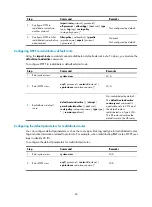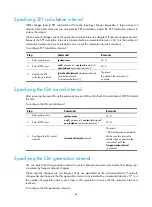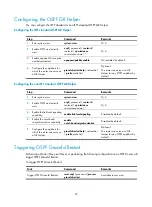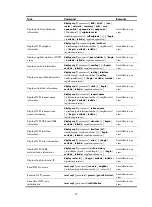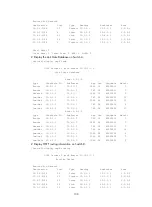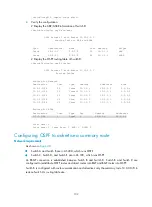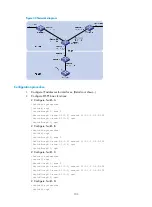
90
Configuring OSPF network management
With trap generation enabled, OSPF generates traps to report important events. Traps fall into the
following levels.
•
Level-3
—Fault traps
•
Level-4
—Alarm traps
•
Level-5
—Normal but important traps
•
Level-6
—Notification traps
The generated traps are sent to the information center of the device. The output rules of the traps such as
whether to output the traps and the output direction are determined according to the information center
configuration. (For information center configuration, see
Network Management and Monitoring
Configuration Guide
.)
To configure OSPF network management:
Step Command
Remarks
1.
Enter system view.
system-view
N/A
2.
Bind OSPF MIB to an
OSPF process.
ospf mib-binding
process-id
Optional.
By default, the OSPF process with
the smallest
process-id
is bound
with OSPF MIB.
3.
Enable OSPF trap
generation.
snmp-agent trap enable ospf
[
process-id
]
[
ifauthfail
|
ifcfgerror
|
ifrxbadpkt
|
ifstatechange
|
iftxretransmit
|
lsdbapproachoverflow
|
lsdboverflow
|
maxagelsa
|
nbrstatechange
|
originatelsa
|
vifcfgerror
|
virifauthfail
|
virifrxbadpkt
|
virifstatechange
|
viriftxretransmit
|
virnbrstatechange
] *
Optional.
Enabled by default.
Enabling message logging
Step Command
Remarks
1.
Enter system view.
system-view
N/A
2.
Enter OSPF view.
ospf
[
process-id
|
router-id
router-id
|
vpn-instance
vpn-instance-name
] *
N/A
3.
Enable message
logging.
enable log
[
config
|
error
|
state
]
Not enabled by default.
Enabling the advertisement and reception of opaque LSAs
With this feature enabled, OSPF can receive and advertise Type 9, Type 10, and Type 11 opaque LSAs.
To enable the advertisement and reception of opaque LSAs:








